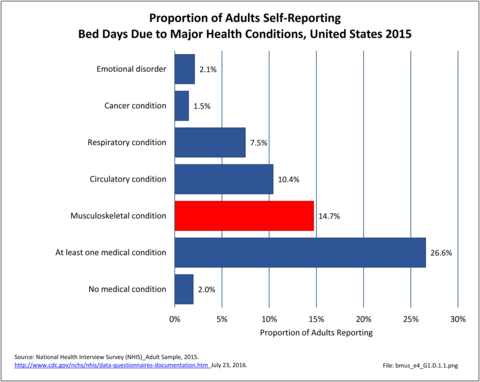 [6]
[6] 

Respondents to the 2015 NHIS self-reported the number of bed days and lost work days they experienced in the previous 12 months due to a variety of medical conditions. A bed day is defined as one-half or more days in bed because of injury or illness in past 12 months, excluding hospitalization. A missed, or lost, work day is defined as absence from work because of illness or injury in the past 12 months, excluding maternity or family leave.
Although the exact cause of these bed and lost work days cannot be determined because some respondents reported multiple health conditions, 70% of persons reporting bed and lost work days reported having a musculoskeletal condition. This is more than twice the proportion of respondents reporting depression, the second most common medical condition listed for causing lost work days, and five or more times the proportion pf respondents reporting other major health conditions. Overall, the high proportion of workers reporting lost work days or bed days as a result of a musculoskeletal condition results in an economic burden on the economy—much higher than that reported for chronic circulatory or chronic respiratory conditions. (Reference Table 1.8.1 PDF [1] CSV [2] and Table 1.8.2 PDF [3] CSV [4])
More than one in four adults in the population (27%), a total of 54 million, reported at least one bed day in the previous 12 months because of a medical condition. More than one-half (14.7%) reported having a musculoskeletal condition, more than reported any other condition. Respondents could report multiple conditions, and bed days could be associated with more than one condition. The mean number of bed days reported with musculoskeletal conditions was 20.4, for a total of 1.1 billion bed days. While other conditions were likely the cause of a higher mean number of bed days, the share of the population reporting these conditions was much smaller.
Males and females reported a similar mean number of bed days due to musculoskeletal conditions (20 days vs 21 days), however, because more females report musculoskeletal conditions and bed days than males, the total bed days attributed to females is much greater. Adults in their middle years, age 45 to 64, report higher rates of bed days because of musculoskeletal conditions than do adults age 18 to 44 or over 65.
More than 35 million adults in the workforce with a musculoskeletal condition reported lost work days in the previous 12 months, totaling nearly 364 million days. Lost work days for persons with a musculoskeletal conditions accounted for more lost work days than any other major health condition, with workers losing an average of 10 days of work. Chronic circulatory conditions, including high blood pressure and heart conditions, accounted for 283 million lost work days, and were reported by an increasing share of the working age population.
As with bed days, females and males reported similar numbers of lost work days, but again, the number of females was higher. The youngest members of the work force, those age 18 to 44, accounted for the largest number of workers with lost work days due to a musculoskeletal condition, but they also represent the largest share of the work force population. They reported a mean of three fewer days lost than the older 45 to 64 worker population. The oldest workers, those age 65 and over, reported a mean of nearly 14 days lost, but comprised a very small share of the work force.
Links:
[1] https://bmus.latticegroup.com/docs/bmus_e4_T1.8.1.pdf
[2] https://bmus.latticegroup.com/docs/bmus_e4_T1.8.1.csv
[3] https://bmus.latticegroup.com/docs/bmus_e4_T1.8.2.pdf
[4] https://bmus.latticegroup.com/docs/bmus_e4_T1.8.2.csv
[5] https://bmus.latticegroup.com/file/bmuse4g1d11png
[6] https://bmus.latticegroup.com/docs/bmus_e4_G1.D.1.1.png
[7] https://bmus.latticegroup.com/file/bmuse4g1d12png
[8] https://bmus.latticegroup.com/docs/bmus_e4_G1.D.1.2.png
[9] https://bmus.latticegroup.com/file/bmuse4g1d21png
[10] https://bmus.latticegroup.com/docs/bmus_e4_G1.D.2.1.png
[11] https://bmus.latticegroup.com/file/bmuse4g1d22png
[12] https://bmus.latticegroup.com/docs/bmus_e4_G1.D.2.2.png